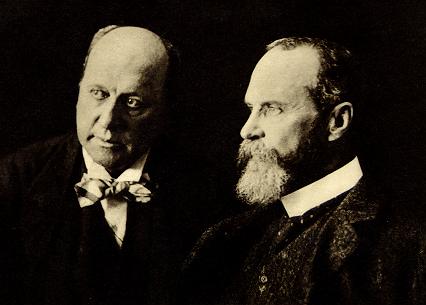"The Demise of the Dollar? Should We Worry about Quantitative Easing and Deficit Spending?
Over the weekend, I was working on my long delayed manuscript on exchange rate modeling [0], and pondering how useful the conventional econometric techniques were for making predictions about the future value of the dollar.

Figure 1: Log value of trade weighted dollar, against a basket of major currencies (blue), and against a broad basket of currencies (red); and Deutsche Bank forecasts, calculated using implied changes of DB TWI (dark blue boxes). NBER defined recession shaded gray; only peak indicated for current recession. Source: Federal Reserve via FRED II, Deutsche Bank Exchange Rate Perspectives (27 March 2009), NBER, and author's calculations.
Why wonder? Well, in the final chapter of the text, I outlined the use of Taylor rule fundamentals to explain exchange rates (see this paper and these posts [1], [2], [3]). However, the fact that several central banks have hit the zero interest rate bound, and instituted quantitative easing (QE), makes the plausibility of such models limited in the near future.

Figure 2: Assets of the Federal Reserve, in billions of dollars, seasonally unadjusted, from Jan 3, 2007 to March 25, 2009. Wednesday values, from Federal Reserve H41 release. Agency: federal agency debt securities held outright; swaps: central bank liquidity swaps; Maiden 1: net portfolio holdings of Maiden Lane LLC; MMIFL: net portfolio holdings of LLCs funded through the Money Market Investor Funding Facility; MBS: mortgage-backed securities held outright; CPLF: net portfolio holdings of LLCs funded through the Commercial Paper Funding Facility; TALF: loans extended through Term Asset-Backed Securities Loan Facility; AIG: sum of credit extended to American International Group, Inc. plus net portfolio holdings of Maiden Lane II and III; ABCP: loans extended to Asset-Backed Commercial Paper Money Market Mutual Fund Liquidity Facility; PDCF: loans extended to primary dealer and other broker-dealer credit; discount: sum of primary credit, secondary credit, and seasonal credit; TAC: term auction credit; RP: repurchase agreements; misc: sum of float, gold stock, special drawing rights certificate account, and Treasury currency outstanding; other FR: Other Federal Reserve assets; treasuries: U.S. Treasury securities held outright. Source: Hamilton, "The Fed's new balance sheet".
At the same time, we are witnessing a substantial increase in government debt, as documented in this post. Working off a portfolio balance model, as discussed in this post, one would expect a depreciation of the dollar or an increase in the exchange risk premium. However, all developed countries are expanding debt to GDP ratios.

Table 1.5 from OECD, Economic Outlook (March 2009) [pdf].
(Notice that gross debt differs from net debt, so these figures are not comparable to those in this post.)
Deutsche Bank, in its most recent Exchange Rate Perspectives (March 27, 2009) [not online], concludes:
Fiscal expansion combined with QE
What is the implication of fiscal expansion combined with QE? We have argued that history suggests the implications of higher fiscal deficits for the dollar will depend on whether or not the higher deficits are accompanied by higher relative US longer-term rates (Fiscal Deficits and the Dollar, ERP, September 2008). So if relatively more activist fiscal policy in the US raises relative US yields, history suggests this should be positive for the dollar. But there is widespread concern that if the higher deficits are accompanied by expectations of or actual QE, this will be negative for the dollar. This is essentially a "risk premium" argument that even with higher relative US yields, because of or under QE, this will be negative for the dollar. Looking at historical experience for episodes of risk premia against the dollar by examining the correlation between daily returns in EURUSD versus the longer-term rate differential indicates six episodes of negative correlations between the differential and the dollar. Four of these are episodes of risk premium in favor of the dollar, with declines in the dollar rate differential associated with a higher dollar. There have only been two episodes—in the late summer and early fall of 1998 and in the summer of 2003 -- when a move in rate differentials in favor of the dollar was associated with a weaker dollar. There have thus historically been very few episodes of such a risk premium. Presently this correlation between changes in the yield differential and the dollar is running around zero to very modestly negative. This is consistent with the view that most of the recent sharp depreciation in the dollar has been in line with the decline in US rate differentials and there is little or no evidence that higher expected fiscal deficits in the US combined with QE have created a risk premium against the dollar ...
Interestingly, this perspective contrasts with Charles Wyplosz's view, who argues that QE is basically a beggar thy neighbor policy. Perhaps it is, but when many countries are undertaking QE [4] [5] the effects cancel out.
What about China? As Brad Setser points out, China has slowed accumulation of Treasurys. How this will play out depends on how much the currency composition of assets changes as a consequence. And indeed whether the slowdown in accumulation persists.
Returning to the question that inspired this post, DB asserts that the long term yield differential will drive the dollar. That seems to be a hypothesis that one will be able to test as the data roll in. So I remain hopeful that the empirical methods of the past will prove yet again useful in the future, despite the changed nature of the world.
[Addition, 8:15pm Pacific It turns out that Barry Eichengreen has already observed this nullification effect -- but adds that it would be better to coordinate QE across countries. See this article from last month.]
By the way, if you're looking for estimates of increased debt-to-GDP stocks on interest rates, see Table 3.5 of the OECD, Economic Outlook (March 2009) [pdf]....you'll see a reference to this paper.
Technorati Tags: zero interest rate policy, quanitative easing, exchange rates, Taylor rule, and portfolio balance.
Posted by Menzie Chinn at April 13, 2009 07:40 PM"







































No comments:
Post a Comment